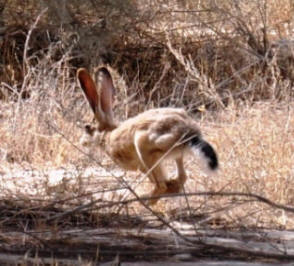

< >
WILDLIFE OF AFGHANISTAN WILDLIFE OF SAUDI ARABIA NORTHWEST WILDLIFE ONLINE
John M. Regan
Here in the US no animal is more closely associated with Easter and the arrival of Spring than the rabbit. No advertiser worth their Easter bona fides would dare launch a campaign minus the too cute image of a little bunny with its tiny nose adorably wriggling beneath those beguiling, innocent eyes. The association of the rabbit with spring is believed to be due to the pre-Christian but very understandable image of the rabbit as a symbol of fertility. We seem to have carried this symbol forward ever since.
But our bouncy and sweet icons, so common that we scarcely give them notice, are a much more interesting mammalian representative than most of us suspect. Once considered rodents these animals have since gained recognition of their own and are now classified in a distinct order called Lagomorpha. Lagomorphs include just three families: Rabbits, Hares, and Pikas. But those three families, with the exception of Antarctica and possibly Madagascar, have conquered the world. Their high fecundity, adaptability, and unique digestive system make them extremely successful animals.


On the left is the familiar cotton tail rabbit, this one an Eastern Cotton Tail. Next is the cutest o the cute - the Pika, peeking out of his rocky den in the Cascades. The big hares like this one photographed in Afghanistan are considerably larger both in body and in ear size than either of their Lagomorph cousins.
Lagomorphs are strict vegetarians. They mainly prefer grass but will chomp down on a wide variety of plants (as anyone with a country garden will tell you) but in lean times they will even eat tree bark. And they are able to extract maximum nutrients from everything they eat thanks to a digestive, although unappealing, trick they have perfected – they eat their own feces – kind of a two for one feeding strategy. Lagomorphs produce two types of fecal pellets. The ones destined for “reconsumption” are noticeably moist; the other is a dry pellet that won’t be eaten again.
What’s the difference between a rabbit, a hare, and a pika? Mainly one of size, although there are some other fairly distinct external features. The hares (often referred to a “jackrabbits’) are the largest members of the order. Many exceed two feet in length and are characterized by a lean body shape, and long limbs, especially the hind limbs, and enormous, upright ears. Here in the Northwest our Snowshoe Hare exemplifies the long limb trait, especially in winter when it sprouts thick white hair on its rear feet. Hares look fast and they are. It is their primary method of escape from danger. Rabbits are smaller. Most are no more than a foot or so in length, have more compact bodies and shorter ears. Not nearly as fast as their long legged cousins these guys are much more dependent on burrowing as a mean of defense. The smallest and rarest is the Pygmy Rabbit subject of a breeding program at Northwest Trek and other zoos in the Northwest.
AT the other end of the Lagomorph size scale we have the animal I like to call the “cutest of the cute.” Coming in at around six to eight inches, about the size of a guinea pig, Pikas are tailless, little brown balls of fur. Their slightly oversized, rounded ears point backwards and give them a cartoonish appearance. They remind me of the mouse in Tom and Jerry. Pikas prefer rocky habitats in high mountainous areas. The next time you’re out in the high country and happened to pass by an area full of rock rubble, listen for a high pitched squeak and look for a movement out of your peripheral vision. Hold still for a minute or two and you just might see the cutest little furry beast you ever saw in your life peeking out at you.
Finally, a few quick thoughts about lagomorphs as pets. Now the big hares are probably impossible to keep. They’re fast, jumpy, and too high strung in nature to become good pets. Pikas are considered an endangered species so forget about them. Bunny rabbits, however, are very popular and very legal. In fact there is a wide range of domestic species with the charming Lop Ear up near the top of the popularity pack. And they do make fairly good pets. Believe it or not rabbits can be housebroken to use a rabbit equivalent of a litter box to deposit feces. (Remember what they do with this, though. You may not enjoy the sight.) But they also chew and gnaw on anything else – to include furniture and your favorite books. They make much better outdoor pets.
My advice, however, is the same for all would be pet owners – make sure you know what you are getting into. And make sure you know what the rabbit is in for. If you get tired of a domestic rabbit and just let the little guy go he will soon die either from a predator or some other environmental factor. These guys have pretty much lost the ability to live in the wild.
HOOAH
Jack
< >
WILDLIFE OF AFGHANISTAN WILDLIFE OF SAUDI ARABIA NORTHWEST WILDLIFE ONLINE
Saudi Arabian Wildlife Afghanistan Wildlife
< >